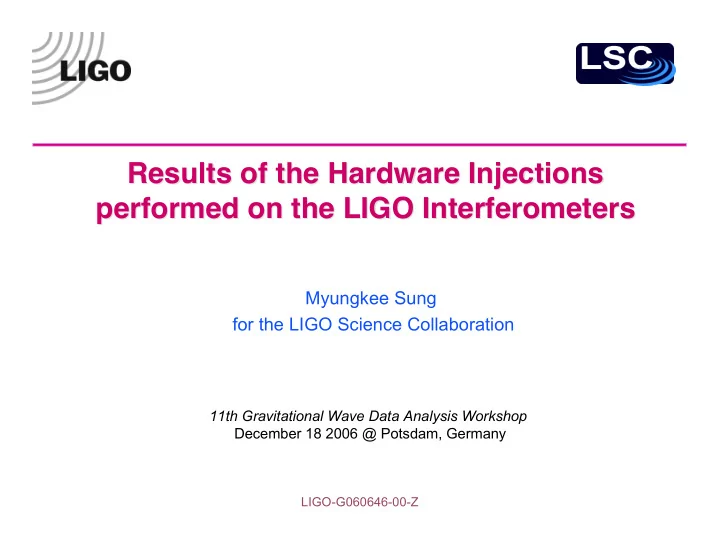

Results of the Hardware Injections Results of the Hardware Injections performed on the LIGO Interferometers Interferometers performed on the LIGO Myungkee Sung for the LIGO Science Collaboration 11th Gravitational Wave Data Analysis Workshop December 18 2006 @ Potsdam, Germany LIGO-G060646-00-Z
LIGO Hardware Injections LIGO Hardware Injections Hardware injections are the only direct test of detector time response. • Detector deforms gravitational waveform in a predictable (?) way. Detector response function quantifies this deformation. Injections are also a good test for measuring the absolute size of signal. • Hardware injections on the S5 run of LIGO • Burst/Inspiral injections, pulsar injections, stochastic injections, special injections. Very little dead time - <0.5% of livetime due to burst/inspiral injections Analysis consists of successive application of linear filters on raw data • (error signal): Whitening filters, applied once and twice. Transformed template (from strain to error signal) Diagnostic tool with prompt analysis after each injections. • KleineWelle analysis of veto safety of auxiliary data channels •
Servo Diagram of IFO Servo Diagram of IFO • Infer strain s(f) from observable DERR(f): s(f) = R(f)DERR(f) • Calibration team measures this detector response function R(t,f) : where open loop gain G 0 (f): G 0 (f) = D(f)A(f)C 0 (f) • EXC x (t) for hardware injections: EXC x (f) = -h inj (f)/ A x (f)
Burst Injections Burst Injections Twenty different burst waveforms in strain, h(t) • Four Gaussians: σ = 0.3, 1.0, 3.0, 10 ms. Sine-Gaussians (Q=9) with 12 frequencies from 50Hz to 3068Hz Supernova waveform: Zwerger-Mueller (A3B3G1) Cosmic string - cusp (f cutoff = 220Hz) Band-limited white noise burst: f = 250Hz, δ f = 100Hz and σ = 30ms Ringdown: f = 2600Hz δ t = 30ms Various settings of strengths and time for each injections • Same waveform injected to three IFOs with time shifts (if in science mode). Two regular injections daily on average, each with three waveforms. Loud injections of Gaussians and sine-Gaussian at least once per week for studying coupling to auxiliary channels and impulse response of detector.
Gaussian ( σ = 0.3ms) injection Gaussian ( σ = 0.3ms) injection • Use actuation function, A x (f), to calculate the excitation function: EXC x (f) EXC x (f) = -h inj (f)/ A x (f) • Note: this injection is approximately an impulse in strain.
Result of injection of injection Result or impulse response impulse response or Zoom-in
Analyzing Injection Data Analyzing Injection Data Matlab scripts (python scripts for controlling jobs) • Use DERR(t) data • Time windows of 64s, Tukey windowing to use the middle 48s • Whitening filters • Single whitening filter: Double whitening filter: Noise estimate, S(f), from two 50s long data before and after injection period.
Whitened DERR DERR Whitened or whitened impulse response or whitened impulse response
Optimal Linear Filter Optimal Linear Filter A standard method from classical signal processing. • Matched filter study: template from injected waveforms with the • detector response function (Calibration): d α (f) = h inj (f)/ R(f) Optimized for the measured stationary noise of detector - Double • whitening. It is also a linear measure of the strength; • Choose normalization so ||h|| is unbiased estimate of true h rss of this waveform. Response functions cancel , i.e., the equivalent expressions for either observable DERR(t) or strain s(t).
Filtered output from loud Gaussian Filtered output from loud Gaussian • Strength Measurement • Injected: 20 10 -21 s 1/2 • Measured: 19.984 10 -21 s 1/2 • rms(noise): 0.0357 10 -21 s 1/2 • Time measurement • Injected time offset: 0.5 s • Measured time offset: 0.5001s Zoom-in
EXC x (t) Supernova waveform: Supernova waveform: Zwerger-Mueller Zwerger-Mueller (A3B3G1) (A3B3G1) • Strength Measurement DERR(t) • Injected: 0.6 10 -21 s 1/2 • Measured: 0.661 10 -21 s 1/2 Single whitened DERR(t) • rms(noise): 0.04168 10 -21 s 1/2 • Time Measurement • Injected offset: 0.3555s • Measured offset: 0.3558s Filtered output
Hardware injection monitoring Hardware injection monitoring - snapshot of online display for - snapshot of online display for scimons scimons - -
Gaussian σ =1ms: Strength Measurement Gaussian σ =1ms: Strength Measurement L1: 452 Injections Δ ||h|| = ||h|| measured -||h|| injected = -0.31 ± 1.1 rms(noise)
Gaussian σ =1ms: Time Measurement Time Measurement Gaussian σ =1ms: Δ t = t measured - t injected = -0.15 ± 0.14 ms
Measuring Burst Injections Measuring Burst Injections Strength Time • Jan. 19 - Aug. 23, 2006 • Number of injections: • H1 - 5018 • H2 - 5958 • L1 - 4098 z
Veto Safety Study using Hardware Injection Veto Safety Study using Hardware Injection Transients identified by KleineWelle algorithm on auxiliary • data channels at the time of injections Injections from 272 days of S5 run • From DERR : • H1 H1 Significance Δ Time (s) Injected ||h||
Veto Safety Study using Hardware Injection Veto Safety Study using Hardware Injection RMP(Recycling Mirror Pitch) - Safe • ASI(Antisymmetric port In-Phase) - Unsafe • Significance Significance Injected ||h|| Injected ||h|| Δ Time (s) Δ Time (s)
Summary Summary Hardware injection provides very useful tools to understand • the performance of interferometers. Injections during S5 are analyzed by using • Whitening filters Optimal linear filters KleineWelle algorithm Prompt result from hardware injections is available and used • as a diagnosis tool. From statistical study, detector response to injected • waveforms is analyzed. Veto safety study on auxiliary data channels with transients • from KleineWelle algorithm.
Recommend
More recommend